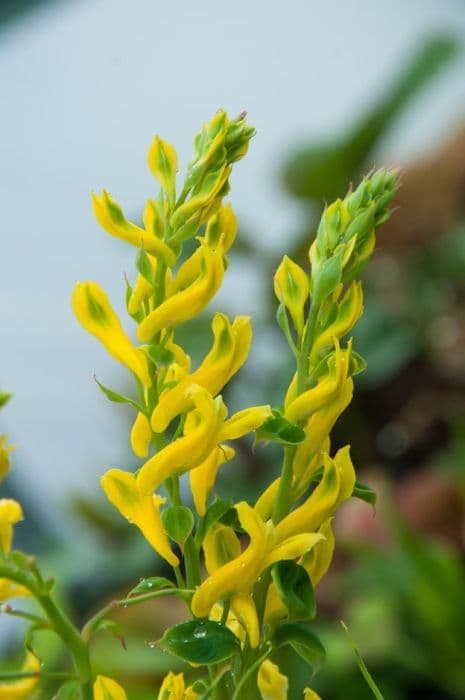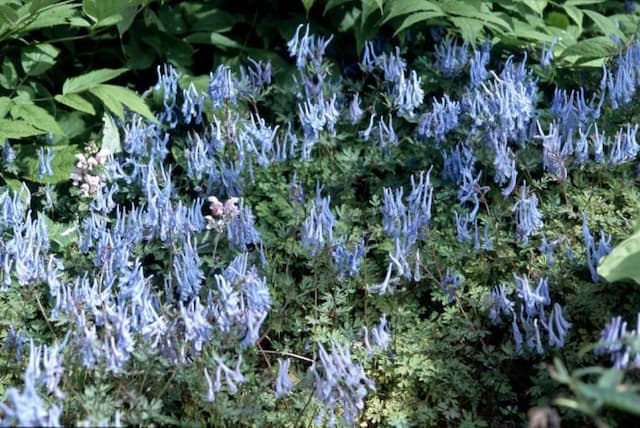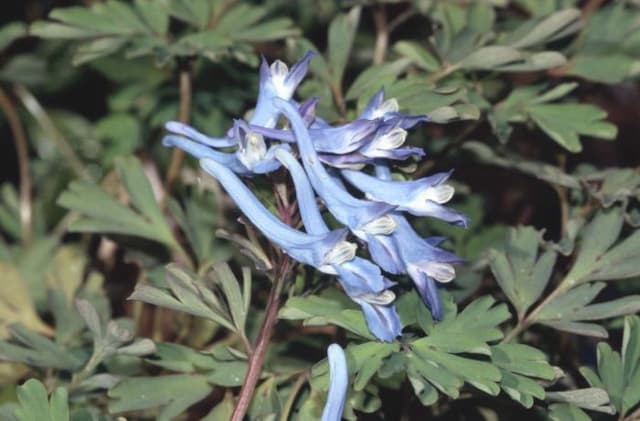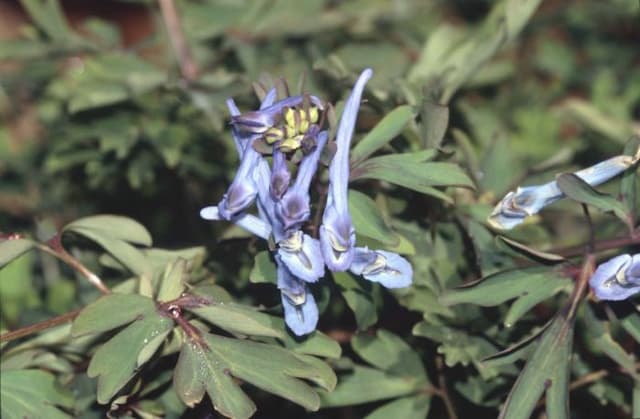Bleeding Heart Dicentra 'Aurora'

ABOUT
Dicentra 'Aurora', commonly known as Bleeding Heart, is a captivating perennial plant recognized for its distinct and ornamental appearance. This plant is characterized by its elegant, arching stems that carry rows of delicate, heart-shaped flowers. The blooms are typically a soft white, adding a touch of grace to the plant's visual appeal. The flowers' unique shape resembles that of a classic "heart," complete with a droplet-shaped bottom, which is where the name Bleeding Heart is derived from. The foliage of the Bleeding Heart 'Aurora' is equally attractive, featuring a bluish-green color and forming a feathery, fern-like texture that serves as a beautiful backdrop to the whimsical flowers. The plant's foliage and blooms create a romantic, cottage-garden aesthetic that is perfect for borders, woodland gardens, or as a captivating focal point in a variety of garden settings. The contrasting bloom and leaf colors, alongside the plant's flowing growth habit, make it a highly sought-after choice for gardeners looking to add a touch of elegance and charm to their outdoor spaces.
About this plant
 Names
NamesFamily
Papaveraceae.
Synonyms
White Bleeding Heart, Alba Bleeding Heart.
Common names
Dicentra 'Aurora'
 Toxicity
ToxicityTo humans
The plant Dicentra 'Aurora', commonly known as bleeding heart, is considered mildly toxic to humans. If ingested, it can cause symptoms such as vomiting, diarrhea, and stomach pain. In some cases, skin contact with the sap can also lead to skin irritation or dermatitis. It is important to keep this plant out of reach of children who might be tempted to eat its attractive flowers or foliage.
To pets
Bleeding heart is also toxic to pets, including dogs and cats. If a pet consumes parts of this plant, they may show signs of poisoning which include drooling, nausea, vomiting, diarrhea, and in severe cases, seizures or tremors. If you suspect your pet has ingested bleeding heart, you should contact a veterinarian immediately. It's crucial to prevent pets from accessing areas where this plant is grown to avoid accidental ingestion.
 Characteristics
CharacteristicsLife cycle
Perennials
Foliage type
Deciduous
Color of leaves
Green
Flower color
White
Height
18 inches (45 cm)
Spread
18 inches (45 cm)
Plant type
Herb
Hardiness zones
5
Native area
Varies
Benefits
 General Benefits
General Benefits- Aesthetic Appeal: Adds delicate white flowers and soft green foliage to the garden, enhancing visual interest.
- Attracts Pollinators: Welcomes bees and butterflies, aiding in the pollination of surrounding plants.
- Shade Tolerance: Thrives in shaded areas where other plants might struggle, filling in garden gaps.
- Spring Blooming: Offers early season blooms, providing a welcome burst of color after winter.
- Easy to Grow: Known for being low maintenance and easy to care for, making it suitable for novice gardeners.
- Compact Size: Perfect for small garden spaces or urban gardens due to its modest growth habit.
- Deer Resistant: Typically not favored by deer, which helps to prevent damage to the plant and surrounding flora.
- Perennial Growth: Comes back year after year, reducing the need for replanting and ensuring lasting garden structure.
 Medical Properties
Medical PropertiesThis plant is not used for medical purposes.
 Air-purifying Qualities
Air-purifying QualitiesThis plant is not specifically known for air purifying qualities.
 Other Uses
Other Uses- Dicentra 'Aurora', commonly known as Bleeding Heart, can be used in fairy or miniature gardens due to its delicate, heart-shaped flowers, adding a whimsical charm to the garden setting.
- The Bleeding Heart's unique flowers can serve as an inspiration for artists and can be a subject in painting or photography, capturing its unique shape and color.
- Its foliage can be incorporated into floral arrangements to add a touch of greenery with a feathery texture, presenting a contrast to the more commonly used glossy leaves.
- Bleeding Heart's flowers can be dried and used in crafting, such as making bookmarks, greeting cards, or in scrapbooking to add natural elements to art projects.
- The plant can be used as a natural dye source, where the flowers provide a subtle color to textiles or other materials without the use of chemicals.
- Bleeding Heart can be a teaching tool in botany or horticulture classes to illustrate the unique structure and pollination strategies of some perennial plants.
- Dried or pressed Bleeding Heart flowers can be used in jewelry making, where they are encapsulated in resin to preserve their shape and color for wearable art.
- The plant can serve as a living memory or tribute in a memorial garden, where its heart-shaped flowers symbolize love and remembrance.
- In landscape design, the Bleeding Heart can be used to create garden themes that invoke storybook or romantic settings, enhancing the narrative aspect of garden spaces.
- Bleeding Heart is sometimes incorporated into relaxation or meditation gardens, where its tranquil appearance promotes a calming and peaceful environment for contemplation.
Interesting Facts
 Feng Shui
Feng ShuiBleeding Heart is not used in Feng Shui practice.
 Zodiac Sign Compitability
Zodiac Sign CompitabilityBleeding Heart is not used in astrology practice.
 Plant Symbolism
Plant Symbolism- Love and Romance: Also known as Bleeding Heart, the Dicentra 'Aurora' is often linked with feelings of love and passion, due to its heart-shaped flowers.
- Expression of Emotions: The unique appearance of the flower, with its 'bleeding' tips, symbolizes the ability to express deep emotions or being open-hearted.
- Compassion and Kindness: The delicate nature of the flower suggests a sense of gentleness, invoking sentiments of compassion and kindness.
- Elegance and Grace: The arching stems and pendulous flowers of the Bleeding Heart plant give it an elegant appearance, symbolizing grace and beauty.
- Rejected Love: In some cultures, the Bleeding Heart plant might symbolize the pain of rejected love or the idea of wearing one’s heart on the sleeve.
 Water
WaterBleeding Heart 'Aurora' should be watered deeply once a week, allowing the soil to slightly dry between waterings. This usually translates to adding about 1 inch of water every week, which is roughly 0.623 gallons for a square foot. Water directly at the base of the plant to avoid wetting the foliage which can lead to fungal diseases. During the active growing season in spring and early summer, keep an eye on the moisture level as Bleeding Hearts prefer consistently moist soil. However, in the dormant period during late fall and winter, you can reduce watering frequency as the plant's water requirements decrease.
 Light
LightBleeding Heart 'Aurora' thrives best in partial shade or dappled sunlight. It's ideal to provide a spot that receives morning sunlight and is protected from the harsh afternoon sun, such as under a canopy of open trees or on the north or east side of a building. Direct sunlight, especially during hot summer months, can scorch the delicate foliage of the Bleeding Heart.
 Temperature
TemperatureBleeding Heart 'Aurora' prefers cool to moderate temperatures and is hardy in USDA zones 3 through 9. It can tolerate winter temperatures down to -40 degrees Fahrenheit and is suited to spring and fall conditions between 55 and 75 degrees Fahrenheit. During the heat of summer, Bleeding Hearts often go dormant if temperatures consistently exceed 75 degrees Fahrenheit and may temporarily wilt to conserve energy and moisture.
 Pruning
PruningPruning Bleeding Heart 'Aurora' typically centers on removing spent flowers and yellowing foliage, which encourages new growth and maintains an attractive shape. Prune right after the flowering season ends, usually in late spring or early summer. Do not prune heavily as the plant prepares for dormancy in late summer or fall; light cleanup is sufficient.
 Cleaning
CleaningAs needed
 Soil
SoilBleeding heart 'Aurora' prefers well-draining, consistently moist soil with a high organic content and should be planted in a soil mix that mimics this environment. The ideal pH range for this plant is slightly acidic to neutral, around 6.0 to 7.0.
 Repotting
RepottingBleeding hearts, including 'Aurora', generally do not need to be repotted frequently and can thrive in the same pot for several years as they are not fast-growing plants.
 Humidity & Misting
Humidity & MistingThe bleeding heart 'Aurora' prefers high humidity levels but can tolerate average room humidity if the soil moisture is maintained consistently.
 Suitable locations
Suitable locationsIndoor
Place in bright indirect light, soil moist, and ensure good air circulation.
Outdoor
Plant in part shade, enrich soil with organic matter, keep moist.
Hardiness zone
3-9 USDA
 Life cycle
Life cycleDicentra 'Aurora', commonly known as Bleeding Heart 'Aurora', begins its life cycle with seed germination, which is dependent on a period of cold stratification to break seed dormancy. The next stage is the seedling phase, where the plant develops its first roots and shoots. As the Bleeding Heart 'Aurora' matures, it enters the vegetative stage, producing distinctive heart-shaped leaves and sturdy stems in preparation for flowering. Flowering typically occurs in late spring to early summer, showcasing the plant's characteristic white, pendant-shaped flowers. After pollination, which is often facilitated by insects, the plant will set seed, completing the reproductive stage of its life cycle. In the final stage, as a perennial, the Bleeding Heart 'Aurora' will die back to the ground in late fall or early winter, entering a period of dormancy until the following spring when the cycle begins anew.
 Propogation
PropogationPropogation time
Spring to early summer
The Bleeding Heart 'Aurora', scientifically known as Dicentra 'Aurora', is typically propagated by division. The most suitable time to propagate by division is in the spring as the plant emerges or in the late fall after the foliage has died back. To propagate by division, one should carefully dig around the plant to lift the clump from the ground. The clump should then be gently separated into smaller sections, ensuring each section has at least one growth bud or eye. These divisions can then be replanted at the same depth they were growing before, spaced around 12 to 24 inches (30 to 60 centimeters) apart, and watered thoroughly to help establish the new plants.









